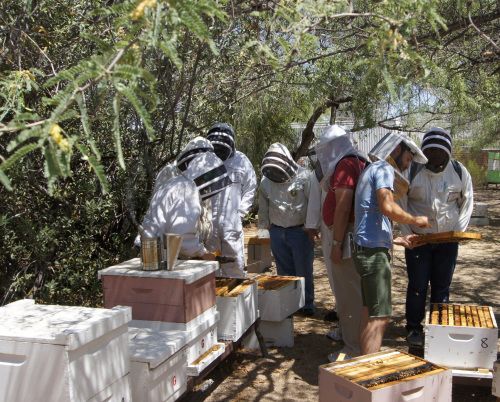
You know that bees are undoubtedly neccesary for food production. You may have also heard that the European honey bee (the bees we keep here in the US for plant pollination as well as honey) is having a hard time due to a threat called Colony Collapse Disorder. CCD is said to be wiping out honey bee populations worldwide, and today biologists everywhere are just at the beginning of understanding the issues surrounding this phenomenon.
Following this discussion, may have also heard that people who can should do their part by keeping a couple of bee hives whether it’s on acreage or their urban or suburban backyards.
This may all be well and good. But today I want to put those issues aside for a moment and simply discuss some of the other reasons that beekeeping is an amazing hobby to take up. What are these bees about and what makes them so special? I’ve got a list that’s certain to pique your interest and believe me when I say that it’s just the tip of the iceberg.
1. Consider a bee colony a “superorganism” because that’s how the bees see themselves. The individuals in a bee colony never work to support themselves as individuals, but rather strictly work together as a single unit to keep the colony alive.
2. Most of the bee colony is made up of working female bees. Workers cannot reproduce — only the queen bee can do that. Each worker bee cycles through one of six jobs within the colony.
It takes about three weeks for the workers to make their way through each indoor job description. The rest of her life (about six more weeks) will be spent searching for pollen and nectar and brining it back to the hive.
- Nurse bees feed the growing larvae and newborn baby bees.
- Clean Up the Dead Crew carries dead adult bees, larvae, and pupa and discard the bodies outside the hive.
- Attendants to the Queen groom, feed, protect the queen while spreading her pheromones throughout the hive.
- House Bees have a long chore list. It includes removing any other garbage (that was tracked in by the rest of the colony) from the hive; taking nectar from the foraging bees and curing it into honey; seal small spaces in the hive with propolis; control the temperature of the hive; and prepare empty brood cells for the next generation of eggs laid by the queen making wax to seal comb or brood inside cells and build new comb.
- Guard bees are destined to risk their lives protecting the hive and the queen within. They hang around the hive’s entrance and are the first to attack a threat and sound the alarm to the rest of the colony.
- Foragers are the mature bees that have already taken their turn at the indoor jobs. They are relied upon to search for food, let others know where to find it, collect pollen, nectar, propolis, and water. They can fly up to sixty miles in a day and finally succumb to exhaustion at the end of their lives, wings tattered and worn by their efforts.
3. Stinger-less drones are the males that are occasionally hatch inside the hive. They are born for one reason only — to find a virgin queen outside the hive and mate with her. It sounds like a dream job until you realize that once he mates, his genitals are torn from his body. Drones live about four to eight weeks.
4. A mature queen (about one week old) flies around in search of a drones (as many as she can find, really) and breeds for only a few days. She ends up collecting all of the sperm that she will ever need to produce children.
5. The queen determines the sex of the bee larvae. She either fertilizes an egg with some sperm, which creates a female worker bee. Or she lays an unfertilized egg which produces a drone.
Let me say that again in case you you missed it. The queen lays an unfertilized egg in which a drone emerges. Yeah, I haven’t figured that part out yet either.
6. It’s the worker bees that get to decide whether another worker is born or a new queen(s). This is how it’s done:
The workers (nurse bees) feed growing larvae a rich fluid called royal jelly. Baby worker bee larvae are only fed royal jelly for several days. If the nurse bees feel that the queen is not producing well or perhaps dying, they will continue to feed several larvae royal jelly. Feeding this superfood creates queen bees.
7. Nurse bees ferment a special blend of honey and pollen (referred to as “bee bread”) and feed it to the larva and the youngest bees. Sometimes adults eat the bee bread, too.
8. Bee “races” have their own personalities. They each have their strong and weak points. While they all have their pros and cons, one thing that the Italian, Russian, and Carniolan bees have in common is that they are all gentle, low-key bees that are easy to handle.
9. Honey is made when the bees mix the nectar, and pollen with n enzyme and place it into a cell in the comb. They proceed to fan it with their wings until it’s cured into honey.
10. If it’s sealed properly, honey never goes bad. Ever. In fact, edible honey sealed in comb has been found in ancient, Egyptian tombs.
Yes, we need bees for food production and we want honey bees (as well as our many native bee species) to visit our vegetable gardens. Yes, we want to enjoy the many honey flavors and the we adore the health benefits of this golden food.
But beyond the pollination; beyond the honey, is the amazing life of the bee colony.




















Comments
Neem honey is a remarkable natural product with diverse health benefits. Its distinct taste, coupled with the numerous medicinal properties of neem, makes it a sought-after alternative to regular honey. Known https://beehoney65.wordpress.com/2023/06/20/neem-honey-the-natural-way-to-boost-your-health/ for its antibacterial, antiviral, and anti-inflammatory properties, neem honey is not only delicious but also a potential ally in promoting overall well-being. Incorporating it into your diet can be a flavorful and health-conscious choice.
Log in or create an account to post a comment.
Sign up Log in